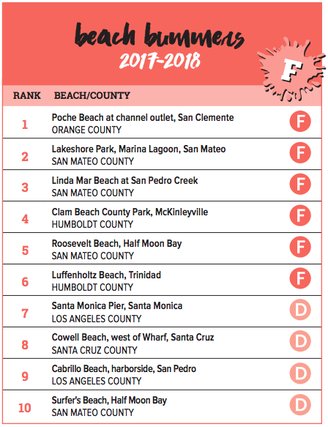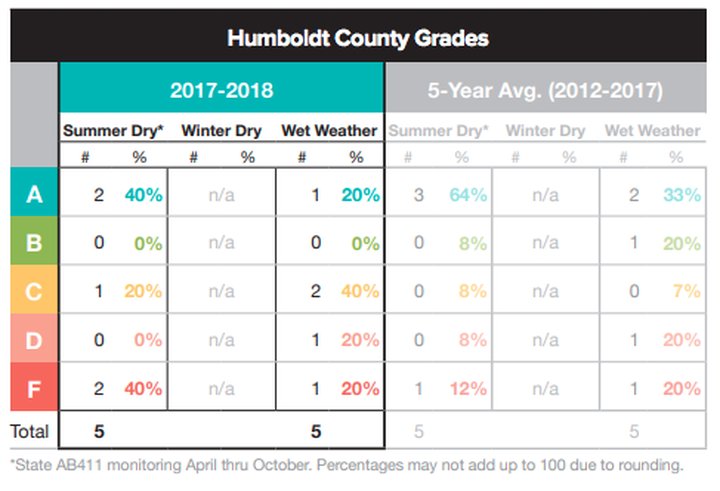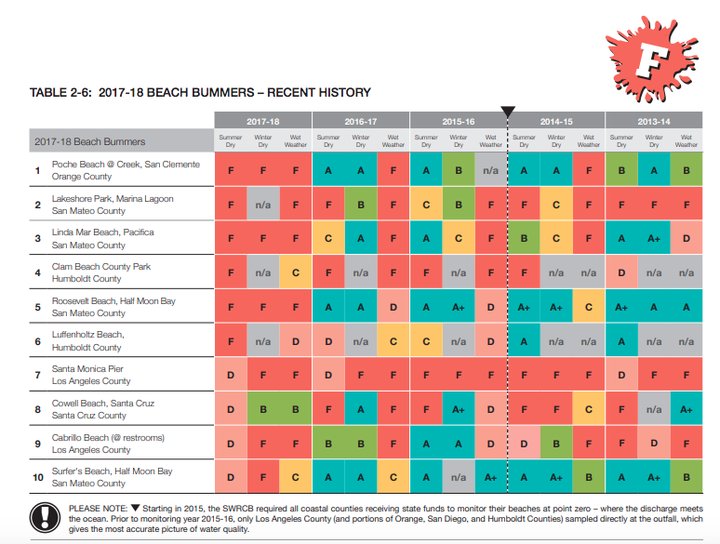Two of Humboldt County’s most-popular beaches are among the filthiest in California once again, according to a report put out by Heal The Bay today.

Humboldt is home to two of this year’s “beach bummers.” Graphics by Heal The Bay.
The environmental nonprofit, dedicated to keeping California’s coastal waters and watersheds clean, listed MckInleyville’s Clam Beach and Trinidad’s Luffenholtz Beach as two of California’s 10 most bacteria-ridden beaches in its annual Beach Report Card.
Among Humboldt’s six monitored beaches, Clam Beach and Luffenholtz Beach both received F grades based on bacterial pollution measurements by county health agencies.
“This is Clam Beach’s fifth consecutive year on the Beach Bummer List, moving down four spots from last year’s No. 1 spot,” the Heal The Bay report reads. [Our math says that’s three spots. -Ed.] “Clam Beach is fed by two creeks, Patrick Creek to the north, and Strawberry Creek from the south.”
While both these beaches have appeared on the “Beach Bummers” list numerous times, Humboldt Baykeeper’s Jen Kalt says no official action has been taken to begin cleaning the beaches because multiple studies are still in the works to identify the main source of bacteria.
“We’re still waiting for results from a genetic study for the source of the pollution,” Kalt told the Outpost this afternoon. “[The study] started in 2016, but the County is still analyzing the data to see if the bacteria came from people, dogs, cattle, wildlife, etcetera.”

Humboldt Baykeeper’s Jen Kalt interviews Harbor District Commissioner Greg Dale in 2014. Kalt was recently featured in an article published by Vanity Fair.
While the official results of the test have yet to be released, Kalt suspects the bacteria is related to human old or broken septic systems draining into these watersheds. Kalt noted that Mad River beach, an area with high concentrations of harbor seals and other wildlife and very few septic systems leading into it, is among the state’s cleanest beaches. It received an A+ rating on the Heal The Bay report.
However, Kalt says the County test results may take some time, because the lab analyzing the data is in Sonoma County and was affected by last year’s wildfires. And while Clam Beach may have dropped in the ranking this year, from the state’s No. 1 stinker of a beach to number four on the list, Kalt says that’s probably just because the other beaches got dirtier.

The number of beaches that received grades in the Heal The Bay report.
“Clam and Luffenholtz are nothing but septic upstream,” Kalt said. “Clam Beach in particular has a large watershed. Strawberry Creek also has high-density water systems close to the creek.”
The quality of Northern California beaches was slightly worse this year overall, according to the report, with 88 percent of beach locations earning an A or B grade for the summer and only 68 percent of beaches receiving an A or B for the winter dry conditions.

Trinidad State Beach wasn’t much better than Clam Beach, still ranking among one of the state’s dirtier beaches with C grading.
Kalt says bacteria is most prevalent during the wet season because rainfall washes more bacteria from the watersheds into the ocean. And while the bacteria has no proven effects on the wildlife, Kalt added that it’s a good rule for humans to avoid these beaches for up to 72 hours after a rainstorm to avoid ingesting the bacteria.
“It can get into people’s eyes, mouths and cuts, making them sick,” Kalt said. “Anytime of the year you can see kids splashing and playing in these waters. Once the bacteria are out of the guts of warm-blooded animals, they die off, that’s why it’s important to wait the 72 hours for them to die off.”

These elevated bacteria levels can also have an effect on Humboldt’s beloved oyster industry.
“The oyster industry in Humboldt has to shut down often times in a rainstorm,” Kalt said. “In winter, they may not be able to harvest for weeks and months at a time. They have to stop harvesting until the bacteria levels die. They test the oysters on a really regular basis.”
Although it’s still unknown when the County’s report will be released, Kalt said the Regional Water Board is conducting its own — much bigger — study on Janes Creek and the Little River, which will hopefully provide our area with better insight sooner than later.
“Those cover dozens of waterways,” she said. “We hope to have the results of that later this summer.”

Mendo’s beaches — in comparison — are much cleaner than Humboldt’s.
CLICK TO MANAGE